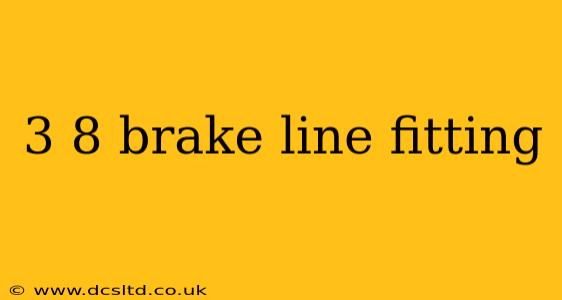Brake lines are critical components of your vehicle's braking system, responsible for transmitting hydraulic pressure from the master cylinder to the calipers or wheel cylinders. A crucial element of these lines is the fitting, specifically the 3/8" brake line fitting, which connects different sections of the line and ensures a leak-free, reliable system. This guide will delve into the intricacies of these fittings, helping you understand their types, applications, and importance for vehicle safety.
What are 3/8" Brake Line Fittings?
3/8" brake line fittings are the connectors used to join sections of brake lines together, typically using a threaded connection. The "3/8"" refers to the nominal outside diameter of the tubing the fitting accommodates. These fittings are crucial for ensuring a sealed and secure connection, preventing leaks that could compromise braking performance and lead to dangerous situations. They come in various types, each designed for specific applications and connection methods.
Types of 3/8" Brake Line Fittings
Several types of 3/8" brake line fittings exist, each serving a unique purpose:
-
Compression Fittings: These are common and involve a sleeve, nut, and fitting body. The nut compresses the sleeve against the tubing and fitting, creating a strong, leak-proof seal. They're relatively easy to install and are widely used in automotive brake systems.
-
Flared Fittings: These fittings require a specific flaring tool to create a precise flare on the brake line tubing. The flared end seats against the fitting, creating the seal when tightened. Flared fittings are known for their robust seal and are often favored for high-pressure applications.
-
Inverted Flare Fittings (Bubble Flare): Similar to flared fittings, but the flare is created on the inside of the tube. This design offers superior strength and resistance to vibration compared to standard flared fittings.
-
Double Flare Fittings: These provide an even more robust seal than single flare fittings, offering extra insurance against leaks under high pressure.
How are 3/8" Brake Line Fittings Used?
The process of installing 3/8" brake line fittings varies slightly depending on the type. Generally, it involves:
-
Preparing the Tubing: This may include cutting the tubing to the correct length and flaring or preparing the end for the chosen fitting type.
-
Installing the Fitting: The fitting is carefully placed over the prepared end of the tubing.
-
Tightening the Fitting: A wrench is used to securely tighten the fitting to the specified torque, ensuring a strong and leak-free connection.
Improper installation can lead to leaks and braking system failure; professional installation is highly recommended.
What Materials are 3/8" Brake Line Fittings Made From?
3/8" brake line fittings are typically made from materials that are resistant to corrosion and can withstand high pressure. Common materials include:
-
Steel: A very common and durable choice offering excellent strength and resistance to corrosion. Often zinc-plated or otherwise coated for added corrosion protection.
-
Brass: Offers good corrosion resistance and is often used in applications requiring a slightly more malleable fitting.
-
Stainless Steel: Offers superior corrosion resistance and strength, making it a preferred material for demanding applications or environments.
How to Identify 3/8" Brake Line Fittings?
Identifying a 3/8" brake line fitting usually involves checking the fitting's diameter and threads. However, it's best to compare the fitting directly to the tubing or other fittings in your brake system to ensure compatibility. Don't rely solely on visual inspection – always double-check with a measuring tool if you have any doubts.
Maintaining and Replacing 3/8" Brake Line Fittings
Regular inspection of your brake lines and fittings is essential for maintaining safe braking performance. Look for signs of corrosion, damage, or leaks. If any issues are detected, the fitting should be replaced immediately. Remember: Compromised brake lines can be incredibly dangerous.
Can I Repair a Leaky 3/8" Brake Line Fitting?
While some minor leaks might seem repairable with sealant, this is generally not recommended for brake lines. Brake lines require a secure, leak-free connection, and attempting a repair with sealant is not a reliable solution. A leaky fitting should always be replaced. Attempting a quick fix could lead to catastrophic braking failure.
What are the consequences of a faulty 3/8" brake line fitting?
A faulty 3/8" brake line fitting can lead to:
- Brake failure: A leak in the brake line will reduce braking pressure, making it harder or impossible to stop the vehicle safely.
- Accidents: Brake failure due to a faulty fitting can result in serious accidents.
- Vehicle damage: Brake fluid leakage can damage other vehicle components.
This comprehensive guide provides essential information about 3/8" brake line fittings. Always prioritize safety when dealing with your vehicle's braking system and consult a qualified mechanic if you are unsure about any aspect of brake line maintenance or repair. Remember, your brakes are critical for your safety and the safety of others on the road.
